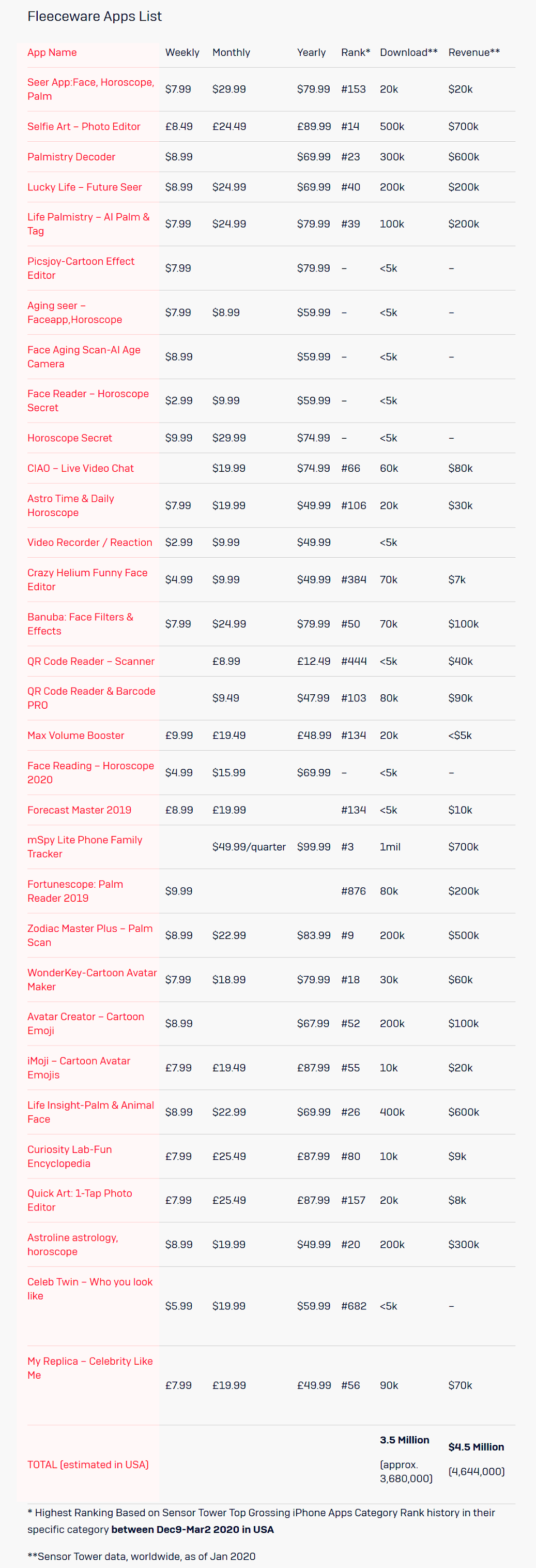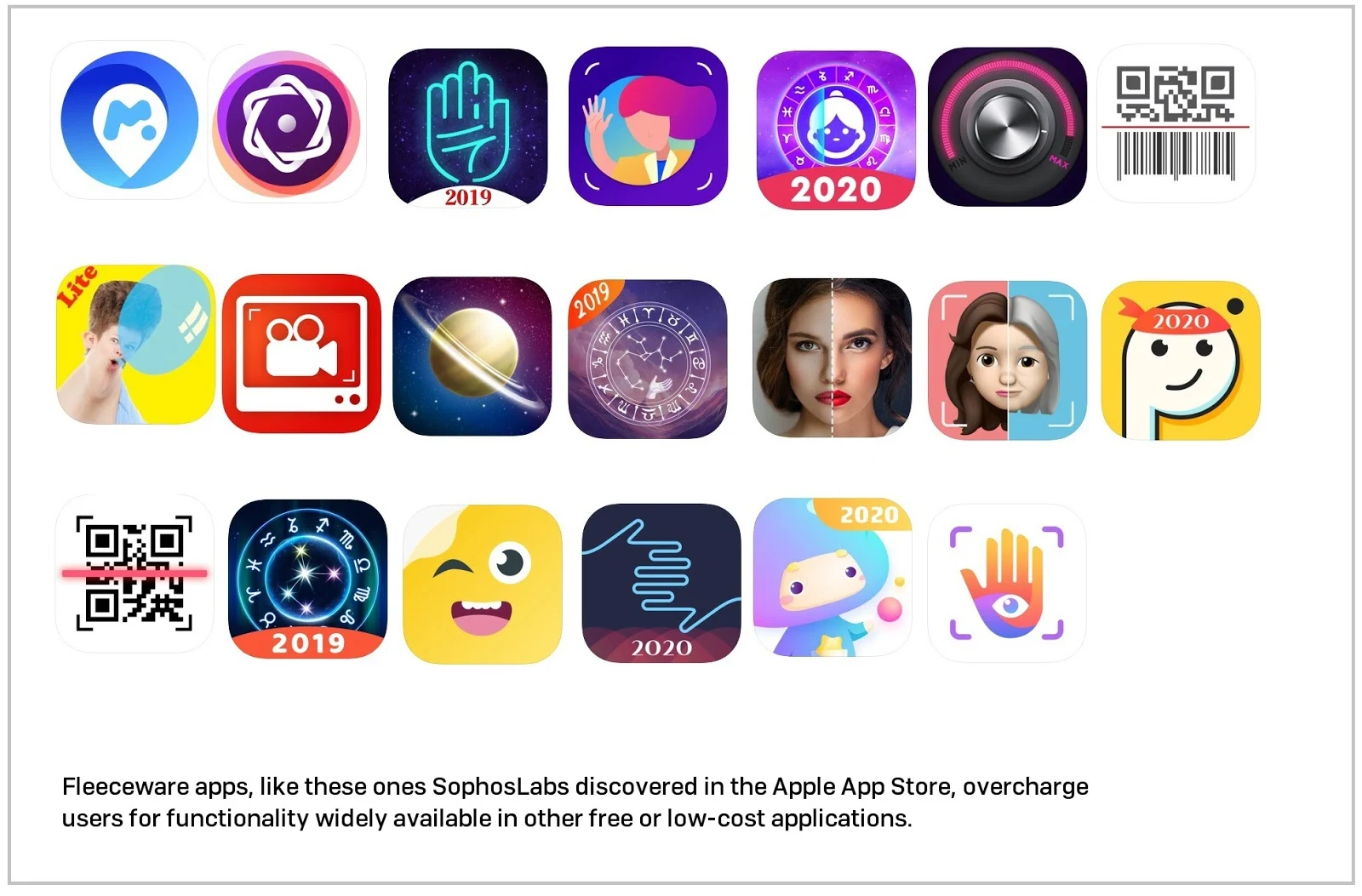More than 2 dozen malicious Fleeceware apps were found in Apple’s official app store. These apps were notably gaining popularity by being actively advertised on all popular social media platforms, such as Instagram, Facebook, Snapchat, etc. Fraudulent app developers were also able to manipulate the app reviews by giving these apps fake 5-star reviews to influence users into installing the apps.
According to a report by Sophos, there have been more than 3.6 million fraudulent app installs reported in the last year, where Apple users became victims of financial frauds through app payments. Similar to the official Apple app store, previously Android’s Google Play store also faced the same problem. Around 600 million users had downloaded fraudulent apps that had caused them financial loss through payment and subscription scams.
According to the newly analyzed data, the majority of these scam iOS apps were of the following categories: picture editor apps; image manipulator apps; face filter apps; QR code apps and fortune-telling/astrology apps. Here is a list of all the malicious fleeceware apps that were found in Apple App Store, if you've have any of them installed in your device, remove them immediately.

The malicious apps were found to abuse the edge Apple gives to its users when installing apps that have subscriptions. Apple allows a free trial period to its users when they download apps that are otherwise paid and charge for subscription. The fraudulent apps exploited this added benefit and would continue to charge an extra amount over the app’s subscription fee after the free trial period was over. The subscription cost was only readable in the lengthy terms of conditions, or the extensive fine prints of the app, which the majority of the users fail to read, resulting in users paying above and beyond their expectations. On top of that, all these apps charged a very high monthly subscription of around $30. After the free trial period expired, the app would immediately charge for the subscription. For active users that had these apps installed for over a year, they were charged between $360 and $450 annually.
Although most of these apps were advertised as free apps with various exciting features, as soon as the users would install them, they would learn that the app did not offer all the marketed features and not a single one of those mediocre features of the app were free. After installation, an app-generated message asking for payments including manual credit card details would pop up. The manual input of bank account details was constantly being tracked down in text and was secretly being transferred to developers, extracting the user’s personal credit card information, which was later hacked and scammed.
Read next: Beware! Sim Swappers can hijack PayPal and Venmo to steal money and other private information
According to a report by Sophos, there have been more than 3.6 million fraudulent app installs reported in the last year, where Apple users became victims of financial frauds through app payments. Similar to the official Apple app store, previously Android’s Google Play store also faced the same problem. Around 600 million users had downloaded fraudulent apps that had caused them financial loss through payment and subscription scams.
According to the newly analyzed data, the majority of these scam iOS apps were of the following categories: picture editor apps; image manipulator apps; face filter apps; QR code apps and fortune-telling/astrology apps. Here is a list of all the malicious fleeceware apps that were found in Apple App Store, if you've have any of them installed in your device, remove them immediately.

The malicious apps were found to abuse the edge Apple gives to its users when installing apps that have subscriptions. Apple allows a free trial period to its users when they download apps that are otherwise paid and charge for subscription. The fraudulent apps exploited this added benefit and would continue to charge an extra amount over the app’s subscription fee after the free trial period was over. The subscription cost was only readable in the lengthy terms of conditions, or the extensive fine prints of the app, which the majority of the users fail to read, resulting in users paying above and beyond their expectations. On top of that, all these apps charged a very high monthly subscription of around $30. After the free trial period expired, the app would immediately charge for the subscription. For active users that had these apps installed for over a year, they were charged between $360 and $450 annually.
Although most of these apps were advertised as free apps with various exciting features, as soon as the users would install them, they would learn that the app did not offer all the marketed features and not a single one of those mediocre features of the app were free. After installation, an app-generated message asking for payments including manual credit card details would pop up. The manual input of bank account details was constantly being tracked down in text and was secretly being transferred to developers, extracting the user’s personal credit card information, which was later hacked and scammed.
Read next: Beware! Sim Swappers can hijack PayPal and Venmo to steal money and other private information

